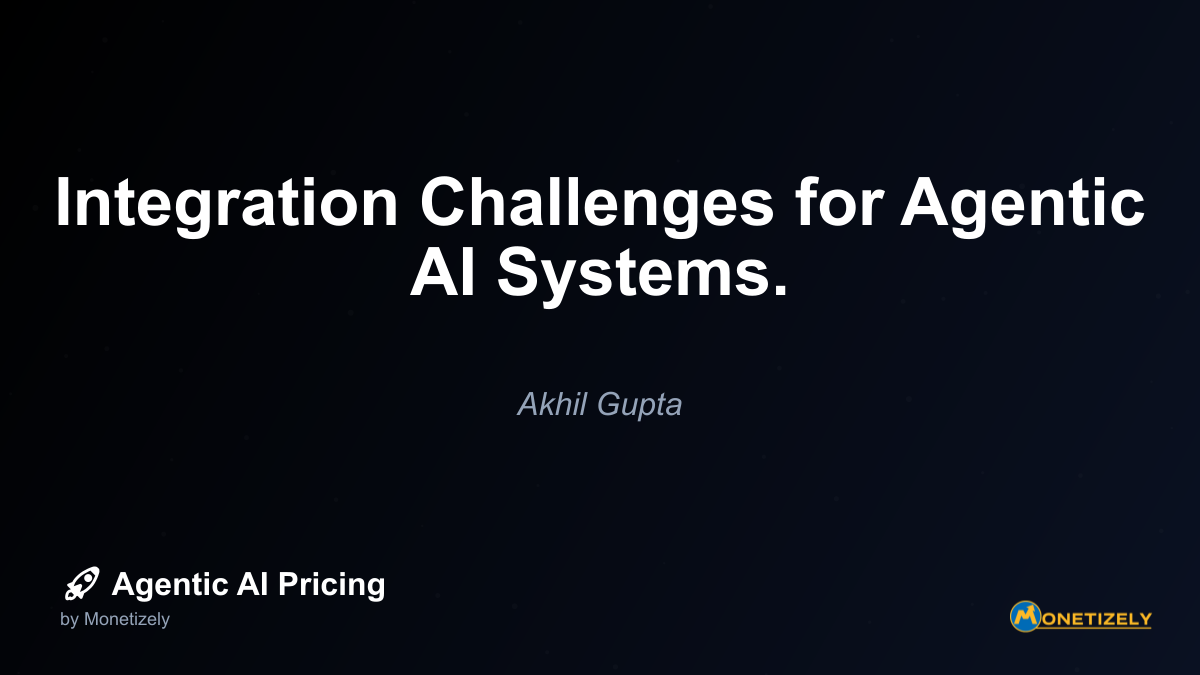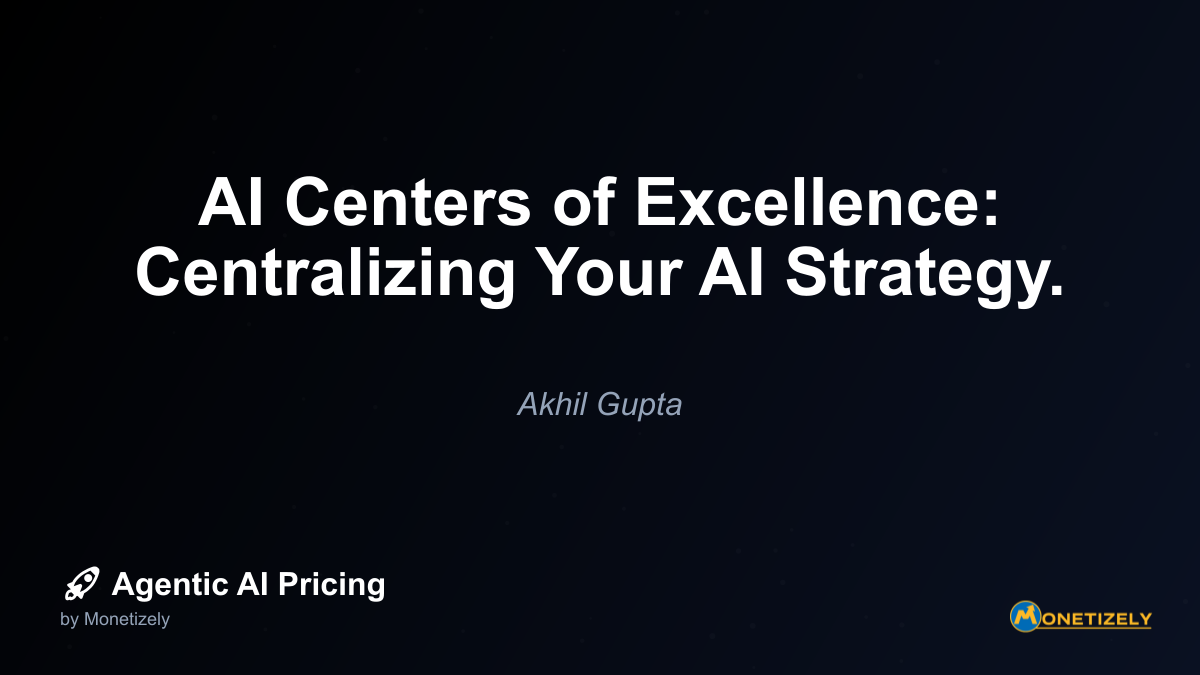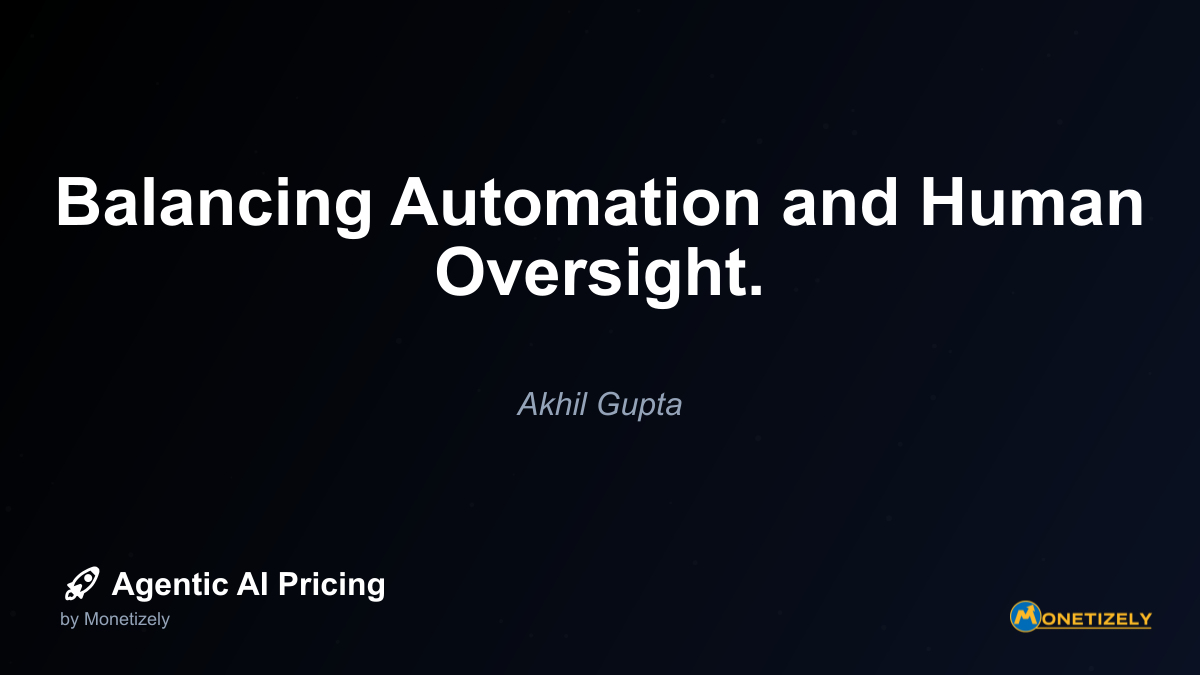· Ajit Ghuman · Implementation Strategies · 10 min read
Managing a Multi-Vendor AI Ecosystem.
AI and SaaS Pricing Masterclass
Learn the art of strategic pricing directly from industry experts. Our comprehensive course provides frameworks and methodologies for optimizing your pricing strategy in the evolving AI landscape. Earn a professional certification that can be imported directly to your LinkedIn profile.

In today’s rapidly evolving technological landscape, organizations are increasingly adopting multiple AI solutions to address various business needs. This approach has given rise to complex multi-vendor AI ecosystems where different AI services handle specialized functions across the organization. While this strategy allows companies to leverage best-of-breed solutions, it also introduces significant challenges in integration, data management, and overall ecosystem governance.
The Rise of Multi-Vendor AI Ecosystems
The adoption of AI across business functions has accelerated dramatically in recent years. Rather than relying on a single vendor for all AI capabilities, organizations are strategically implementing specialized solutions from different providers. A typical enterprise might use one vendor’s AI for customer service automation, another for predictive analytics, and yet another for content generation or knowledge management.
This multi-vendor approach offers several advantages. Organizations can select the best solutions for specific use cases rather than settling for the limited capabilities of a single provider. It also reduces vendor lock-in risk and allows companies to remain agile as AI technologies evolve at different rates across various domains.
However, this fragmented approach creates significant complexity. Without proper management strategies, organizations risk creating AI silos where valuable data and insights remain trapped within individual systems, undermining the transformative potential of their AI investments.
Common Challenges in Multi-Vendor AI Environments
Integration Complexities
Perhaps the most immediate challenge in a multi-vendor AI ecosystem is integration. Each AI solution typically has its own APIs, data formats, and operational requirements. Creating seamless connections between these systems requires careful planning and often custom development work.
Integration challenges manifest in several ways:
- Data format inconsistencies: Different AI systems may use incompatible data structures and formats, requiring transformation layers.
- Authentication and security variations: Each system may implement different security protocols, complicating unified access management.
- API limitations: Some vendors may impose rate limits or have incomplete APIs that restrict integration possibilities.
- Versioning conflicts: Updates to one system may break integrations with others, creating ongoing maintenance challenges.
Data Silos and Fragmentation
AI systems are only as effective as the data they can access. In multi-vendor environments, data often becomes fragmented across different platforms, creating silos that limit each system’s effectiveness.
For example, a customer service AI might have valuable interaction data that could enhance marketing personalization AI, but without proper data sharing mechanisms, these insights remain isolated. This fragmentation undermines the holistic understanding that AI promises to deliver.
Inconsistent User Experiences
When employees or customers interact with multiple AI systems, inconsistencies in interface design, interaction patterns, and capabilities can create confusion and frustration. These inconsistencies increase training requirements and may reduce adoption rates.
Governance and Compliance Challenges
Managing compliance across multiple AI systems presents significant challenges. Different vendors may have varying approaches to data privacy, bias mitigation, and explainability. Organizations must implement overarching governance frameworks to ensure all systems adhere to regulatory requirements and ethical standards.
Cost Management Complications
Multiple AI vendors mean multiple contracts, pricing models, and billing cycles to manage. Without centralized oversight, organizations may struggle to track total AI spending and evaluate return on investment across the ecosystem.
Strategies for Effective Multi-Vendor AI Ecosystem Management
Despite these challenges, organizations can implement several strategies to effectively manage multi-vendor AI ecosystems and maximize their value.
1. Develop a Comprehensive Integration Strategy
A successful multi-vendor environment requires a deliberate integration strategy that addresses both technical and organizational aspects.
Technical Integration Approaches
Several technical approaches can facilitate integration in multi-vendor AI environments:
API Management Platforms: Implementing an API management platform provides a centralized way to monitor, secure, and govern interactions between different AI systems. These platforms can handle authentication, rate limiting, and provide visibility into integration performance.
Middleware Solutions: Purpose-built middleware can translate between different AI systems, handling data transformation and orchestrating complex workflows that span multiple vendors.
Event-Driven Architecture: Adopting an event-driven architecture allows different AI systems to communicate asynchronously through a central event bus. When one system generates an event (like a customer support ticket creation), other systems can react accordingly without direct point-to-point integration.
Microservices Approach: Breaking down integration needs into small, focused microservices can make the overall system more maintainable and adaptable to changes in the vendor landscape.
Organizational Integration Approaches
Technical solutions alone aren’t sufficient. Organizations must also address the human and process elements:
Cross-Functional Integration Teams: Establish teams with representatives from different business units to ensure integrations address actual business needs rather than just technical requirements.
Integration Governance: Develop clear policies for how new AI systems should be integrated into the existing ecosystem, including standards for data sharing, authentication, and user experience consistency.
Integration Documentation: Maintain comprehensive documentation of all integration points, data flows, and dependencies to facilitate troubleshooting and future modifications.
2. Implement a Unified Data Strategy
To overcome data silos, organizations need a unified data strategy that spans all AI vendors and systems.
Data Lake/Warehouse Approach
A central data repository—whether a data lake, data warehouse, or hybrid solution—can serve as the foundation for a unified data strategy. This approach allows organizations to:
- Collect and store data from all AI systems in a standardized format
- Provide a single source of truth for all AI applications
- Enable cross-system analytics that weren’t possible in siloed environments
- Implement consistent data governance policies across all AI data
Master Data Management
Implementing master data management (MDM) practices ensures that critical reference data—like customer information, product catalogs, and organizational hierarchies—remains consistent across all AI systems. This consistency is essential for meaningful integration and accurate analytics.
Data Sharing Agreements
Establish clear internal agreements about how data can be shared between different AI systems and vendors. These agreements should address:
- Which data elements can be shared with which systems
- Required transformations or anonymization before sharing
- Retention policies for shared data
- Feedback mechanisms to improve data quality over time
3. Create a Unified Governance Framework
A comprehensive governance framework helps ensure that all AI systems—regardless of vendor—adhere to organizational standards for security, compliance, and ethics.
Centralized Policy Management
Develop centralized policies for critical aspects of AI governance, including:
- Data privacy and protection: Consistent standards for handling sensitive information across all AI systems
- Ethical AI use: Guidelines for ensuring AI systems operate fairly and without harmful bias
- Transparency requirements: Standards for explainability and documentation across all AI implementations
- Security protocols: Unified security requirements that all vendors must meet
Vendor Assessment and Monitoring
Establish a systematic approach to evaluating and monitoring AI vendors:
- Pre-implementation assessment: Evaluate potential vendors against governance requirements before adoption
- Ongoing compliance monitoring: Regularly audit vendors to ensure continued adherence to standards
- Incident response protocols: Clear procedures for addressing governance failures across the ecosystem
- Vendor scorecards: Maintain comparative assessments of how well each vendor meets governance standards
4. Establish Centralized Metrics and Reporting
To gain a holistic view of AI performance across vendors, organizations need centralized metrics and reporting capabilities.
Key Performance Indicators (KPIs)
Develop a consistent set of KPIs that can be applied across different AI vendors and use cases:
- Business impact metrics: How each AI system contributes to key business outcomes
- Technical performance metrics: Response times, accuracy rates, and other technical indicators
- User adoption metrics: How frequently and effectively users engage with each AI system
- ROI calculations: Standardized approaches to measuring return on investment
Unified Dashboards
Implement dashboards that aggregate metrics from all AI systems to provide:
- Executive-level views of overall AI performance and business impact
- Operational insights for day-to-day management of the AI ecosystem
- Comparative analysis to identify high and low-performing AI investments
- Trend analysis to spot emerging issues or opportunities
5. Build a Center of Excellence for AI Management
A dedicated AI Center of Excellence (CoE) can provide the specialized expertise needed to manage a complex multi-vendor ecosystem effectively.
Core Functions of an AI CoE
The CoE should be responsible for:
- Strategic vendor management: Coordinating vendor relationships, contract negotiations, and performance reviews
- Integration oversight: Ensuring all systems work together according to organizational standards
- Knowledge sharing: Disseminating best practices and lessons learned across the organization
- Skill development: Building internal capabilities to effectively manage and utilize AI systems
- Innovation facilitation: Identifying new opportunities to extract value from the AI ecosystem
Staffing Considerations
An effective AI CoE requires a mix of technical and business expertise:
- Technical architects who understand integration challenges and solutions
- Data scientists who can work across different AI platforms and methodologies
- Business analysts who can translate between technical capabilities and business needs
- Change management specialists who can facilitate adoption of new AI capabilities
Implementation Roadmap for Managing Multi-Vendor AI
Transitioning to an effectively managed multi-vendor AI ecosystem requires a phased approach:
Phase 1: Assessment and Strategy Development (3-6 months)
- Inventory existing AI systems and their current integration points
- Identify critical data flows and sharing requirements
- Evaluate governance gaps and compliance risks
- Develop integration, data, and governance strategies
- Secure executive sponsorship and resource commitments
Phase 2: Foundation Building (6-12 months)
- Implement core integration infrastructure (API management, data lake, etc.)
- Establish the AI Center of Excellence with initial staffing
- Develop and communicate governance policies
- Create baseline metrics and reporting capabilities
- Address highest-priority integration gaps and data silos
Phase 3: Ecosystem Optimization (Ongoing)
- Continuously refine integration approaches based on emerging needs
- Expand data sharing capabilities to enable new use cases
- Evolve governance frameworks to address new regulations and ethical considerations
- Enhance metrics to provide deeper insights into ecosystem performance
- Optimize vendor portfolio based on performance and strategic alignment
Case Study: Financial Services Multi-Vendor AI Management
A global financial services firm implemented a multi-vendor AI strategy with specialized solutions for fraud detection, customer service, investment recommendations, and operational analytics. Initially, these systems operated independently, creating significant integration challenges and data inconsistencies.
The firm established a comprehensive management approach:
Integration Layer: They implemented an API gateway and event bus architecture that allowed their different AI systems to communicate seamlessly.
Unified Data Platform: A central data lake collected information from all AI systems, enabling cross-system analytics and ensuring consistent data for training and operations.
Governance Framework: They established a dedicated AI ethics committee and governance team to ensure all systems adhered to regulatory requirements and ethical standards.
Metrics Dashboard: A centralized dashboard tracked performance across all AI systems, allowing executives to see the holistic impact of their AI investments.
AI Center of Excellence: A dedicated team managed vendor relationships, facilitated knowledge sharing, and drove continuous improvement across the ecosystem.
The results were significant:
- 40% reduction in integration development time for new AI capabilities
- 65% increase in cross-selling effectiveness through better data sharing
- 30% improvement in fraud detection through combined insights from multiple systems
- Streamlined compliance reporting that reduced audit preparation time by 50%
Future Trends in Multi-Vendor AI Management
As multi-vendor AI ecosystems continue to evolve, several trends are emerging that will shape management approaches:
AI Orchestration Platforms
Specialized platforms that can coordinate workflows across multiple AI systems are emerging. These platforms provide pre-built connectors, workflow automation, and centralized monitoring specifically designed for AI ecosystems.
Federated Learning Approaches
Rather than centralizing all data, federated learning allows AI models to be trained across multiple systems while keeping data in place. This approach may reduce integration complexity while still enabling cross-system learning.
Standardized AI Interfaces
Industry efforts to standardize AI interfaces and data formats are gaining momentum. These standards could significantly reduce integration challenges in multi-vendor environments.
AI Marketplaces
Enterprise AI marketplaces are emerging as a way to simplify the discovery, procurement, and integration of multiple AI capabilities. These marketplaces often include pre-built integration capabilities and unified governance controls.
Conclusion
Managing a multi-vendor AI ecosystem effectively requires a strategic, multifaceted approach. By implementing comprehensive integration strategies, unified data approaches, centralized governance, consistent metrics, and dedicated expertise through a Center of Excellence, organizations can overcome the inherent challenges of multi-vendor environments.
The effort required is substantial, but so are the potential rewards. Organizations that master multi-vendor AI management can leverage specialized capabilities from different providers while maintaining a cohesive, efficient, and compliant ecosystem. This balanced approach delivers the best of both worlds: specialized AI excellence without fragmentation and silos.
As AI continues to transform business operations, the ability to effectively manage complex, multi-vendor ecosystems will become an increasingly important competitive differentiator. Organizations that develop this capability now will be well-positioned to adapt and thrive as AI technologies continue to evolve.
Co-Founder & CEO
Ajit is the author of Price To Scale, a top book on SaaS Pricing and is the Founder of Monetizely. Ajit has led and worked in pricing and product marketing at firms like Twilio, Narvar and Medallia. His work has been featured in Forbes and VentureBeat. Ajit regularly consults with software companies from Seed stage to post-IPO on pricing strategy. Ajit is also a highly-rated co-instructor for 'The Art of SaaS Pricing and Monetization' on Maven.
Pricing Strategy Audit
Let our experts analyze your current pricing strategy and identify opportunities for improvement. Our data-driven assessment will help you unlock untapped revenue potential and optimize your AI pricing approach.




